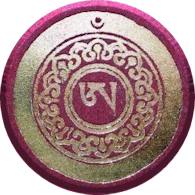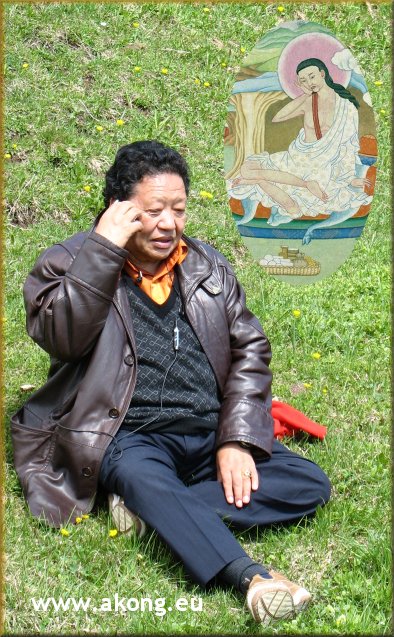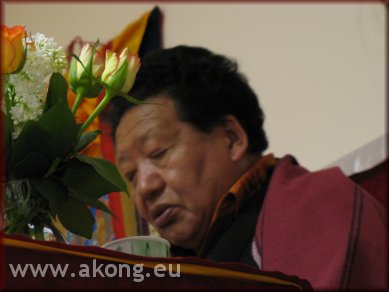
Akong Rinpoche Establishing Buddha-Dharma
Part Fourteen. Establishing the Kagyu practice dharmas of drol-lam, the Mahamudra trainings, and tap-lam, i.e. Traditional Long-Term Retreats and in particular the Six Yogas of Naropa: overview
 Akong Rinpoché was a lama holding both Kagyu and Nyingma lineages, received both before and after leaving Tibet. His own root teachers in Tibet, in particular Secchen Kongtrul Rinpoché, were, as were many lamas, holders of both lineages. Akong Rinpoché did not have the time to follow up many trainings before leaving Tibet but he had completed one—the Mahamudra teachings very dear to his
heart—in the intense time that he spent at Secchen monastery becoming a vajracharya and a master of Mahamudra through his own step-by-step training in the transmission of the Mahamudra, Ocean of Certainty teachings from the IXth Gyalwa Karmapa Wangchuk Dorje.
Akong Rinpoché was a lama holding both Kagyu and Nyingma lineages, received both before and after leaving Tibet. His own root teachers in Tibet, in particular Secchen Kongtrul Rinpoché, were, as were many lamas, holders of both lineages. Akong Rinpoché did not have the time to follow up many trainings before leaving Tibet but he had completed one—the Mahamudra teachings very dear to his
heart—in the intense time that he spent at Secchen monastery becoming a vajracharya and a master of Mahamudra through his own step-by-step training in the transmission of the Mahamudra, Ocean of Certainty teachings from the IXth Gyalwa Karmapa Wangchuk Dorje.
Although—to his own expressed regret—he had not had the opportunity to do a three-year closed retreat, he had nevertheless received training and transmission in the key elements of the Six Yogas of Naropa. He also held much knowledge of the “secret” practices involving various seed syllables, chakras and so forth, used as either meditation or health remedies, as the author witnessed as his secretary or interpreter for Rinpoché’s one-to-one advice to people. In brief, Akong Rinpoché was a master of Mahamudra who understood perfectly both its aspects of tap-lam and drol-lam .
From the early 1970s and in particular in his discussions with the Gyalwang Karmapa and the Very Venerable Kalu Rinpoché, he knew that it would only be when both aspects were firmly established in Samye Ling (or its satellite centres) that it would be truly a Kagyu centre rather than just a general dharma centre. To establish each of these, very properly, in the West was one of his main stated life aims.
The tap-lam teachings centre around the transmission of the Six Yogas, received in India by Naropa from Tilopa and passed to the Tibetan Marpa:
1. Tummo, the famous candali yoga of “inner heat”.
2. Illusory Body
3. Dream Yoga
4. Clarity (“Clear Light”)
5. Bardo (intermediate states)
6. Powa (transference of consciousness)
In India and Tibet, these practices had each been a transmission in its own right. Tilopa had gathered them together as the heart-essence of more than one hundred different tantric lineages. In the Kagyu tradition in Tibet, a system developed whereby they became taught and practised as the core teachings of a three-year retreat, comprising the ngondro or foundation practices, trainings in various guru-yogas and yidams, particularly Vajravarahi and Chakrasamvara and especially these Six Yogas. The main Karma Kagyu monasteries of Tibet—Tsurphu, Palpung, Karmi Gon and so forth—each had their own detailed systems of conducting such retreats.
In general, one can say very broadly that these teachings involve all the aspects of tantra, summed up as creation stage—visualisations, mantras, use of musical instruments, making of tormas, use of physical yoga as yantra-yoga, hatha-yoga and pranayama etc.—and completion stage. The training is complex and very intense.
The drol-lam teachings of Mahamudra, by contrast, use an absolute minimum of visualisation and so forth and instead concentrate on mind itself, according to the Mahamudra teachings on the nature of mind received from Maitripa and Naropa by Marpa and originating principally in the teachings of Saraha and his disciples. The actual practice of these teachings is summed up by the two phases of shamatha and vipasyana.
Drol-lam and tap-lam are each considered to be powerful routes to enlightenment. As the centuries went by, in Tibet, they often became taught in parallel. The bottom line is that, in the end, tap-lam is subordinate to drol-lam.
 “The Six Yogas are like a ladder to the roof. The roof is Mahamudra. When you get on the roof, the ladder is of no more use.”
“The Six Yogas are like a ladder to the roof. The roof is Mahamudra. When you get on the roof, the ladder is of no more use.”
Drol-lam is more attractive to most Westerners than tap-lam, as it avoids all the complexity of tantra and retreat. However, most contemporary masters agree that the fastest way to the roof is that going straight up the ladder of the Six Yogas and retreat ... and that the winding inner stairwell of Mahamudra is too easily misunderstood, making it less user-friendly than it may at first seem.
.....this narrative continues: Establishing the Mahamudra training
